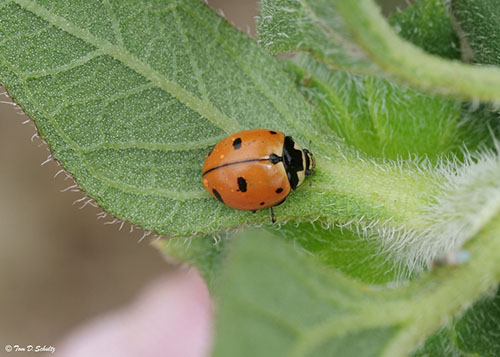Nine-spotted Lady Beetle

Species information
The following is a report on progress made towards the protection and recovery of Nine-spotted Lady Beetle (Coccinella novemnotata) in Ontario from 2007 to 2023, based on Ontario’s species-specific recovery policy. This report meets the legislative requirement for a review of progress under the Endangered Species Act, 2007 (ESA or “the Act”). Nine-spotted Lady Beetle is listed as endangered on the Species at Risk in Ontario (SARO) List under the ESA.
Nine-spotted Lady Beetle was listed as an endangered species under the ESA on June 2, 2017.
Nine-spotted Lady Beetle has been protected from being killed, harmed, harassed, captured or taken since 2017.
In addition, the habitat of Nine-spotted Lady Beetle has been protected from being damaged or destroyed since 2017.
The species-specific recovery policy for Nine-spotted Lady Beetle, known as the government response statement (GRS) was published in 2019 and includes the government’s recovery goal for the species and the actions and priorities it intends to lead or support to help achieve that goal. The GRS considers science advice provided in the recovery strategy (published in 2018), regarding things such as the species biology, habitat needs, threats to survival, knowledge gaps and approaches to recovery, when developing recovery actions for the species. As legislated in the Act, the purpose of this review is to report on progress made towards implementing the protection and recovery actions in the GRS. The review can also help identify opportunities to adjust and adapt the implementation of protection and recovery actions to achieve the recovery goal for the species.
Further information about Nine-spotted Lady Beetle, including the threats that it faces and actions being taken to help protect and recover this species, is available on the Government of Ontario webpage for Nine-spotted Lady Beetle. A summary on the progress towards the protection and recovery of Nine-spotted Lady Beetle and an annual update on the broader species at risk program (i.e. the Introduction to the 2024 Review of Progress report) is available on the Review of Progress towards the Protection and Recovery of Ontario’s Species at Risk webpage.
Snapshot: Progress towards the protection and recovery of Nine-spotted Lady Beetle
Progress towards meeting the recovery goal
- The recovery goal in the government response statement (GRS) for Nine-spotted Lady Beetle in Ontario is to “support the persistence of the species in Ontario by filling knowledge gaps related to the species’ current status and distribution, habitat use, and threats in order to better inform protection and recovery actions” and to “support investigating the necessity and feasibility of reintroduction and of augmenting existing populations”.
- Progress has been made towards implementing several of the government-led actions. Progress has been made towards implementing several of the government-supported recovery objectives and several of the associated actions. Examples of progress include:
- developing and testing techniques for a standardized survey protocol to help confirm whether Nine-spotted Lady Beetle is present in Ontario
- developing and carrying out public outreach programs in Ontario which have resulted in public engagement and widespread data collection across the province
- conducting comprehensive insect surveys and anecdotal observations at several locations throughout Ontario and submitting the data to Ontario’s central repository
- In alignment with the GRS, further work is required to:
- undertake collaborative research, including work with other jurisdictions, to better understand potential causes of decline and current threats, such as the effects of introduced non-native lady beetles, pathogens and parasites, and pesticides (e.g., neonicotinoids) on both the Nine-spotted Lady Beetle and its prey
- investigate the necessity and feasibility of augmenting or reintroducing the species in areas with suitable habitat
- collaborate with organizations, landowners, land managers, and Indigenous communities and organizations to promote awareness among people engaged in agricultural, gardening and stewardship activities in Ontario
Occurrences and distribution
- Ninety-nine populations
footnote 1 of Nine-spotted Lady Beetle have been documented throughout Ontario. Currently, all populations are considered historicalfootnote 2 . The species has not been documented in Ontario since 1987.
Government-supported stewardship projects
- Through the Species at Risk Stewardship Program, the Government of Ontario has enabled its stewardship partners to conduct one project that has supported the protection and recovery of multiple species at risk, including Nine-spotted Lady Beetle, through a multi-species survey, while a second project focused exclusively on Nine-spotted Lady Beetle.
- The government’s support helped its stewardship partners to involve 39 individuals who volunteered 608 hours of their time towards protection and recovery activities for species at risk, including Nine-spotted Lady Beetle. The estimated value of these voluntary contributions, as well as additional funding and in-kind support, is $77,520.
- Stewardship partners reported providing outreach on multiple species at risk, including Nine-spotted Lady Beetle, to 12,651 individuals.
Supporting human activities while ensuring appropriate support for species recovery
- Three activities have been undertaken in accordance with a conditional exemption that requires registration under the ESA. The activities followed the conditional exemption for ‘drainage works’ (section 23.9) under Ontario Regulation 242/08 of the ESA. To date, no permits have been issued for this species.
Reporting on the progress towards the protection and recovery of Nine-spotted Lady Beetle
Recovery goal
The government’s goal for the recovery of Nine-spotted Lady Beetle is to support the persistence of the species in Ontario by filling knowledge gaps related to the species’ current status and distribution, habitat use, and threats in order to better inform protection and recovery actions. The government supports investigating the necessity and feasibility of reintroduction and of augmenting existing populations.
The implementation of government-led and government-supported actions demonstrates progress towards reaching the desired objectives and the recovery goal set out in the GRS.
Progress towards implementing government-led actions
Progress has been made towards implementing several government-led actions identified in the GRS. Common actions for the government to lead as it works towards achieving a species’ recovery goal include:
- Educate other agencies and authorities involved in planning and environmental assessment process on the protection requirements under the ESA.
- Encourage the submission of Nine-spotted Lady Beetle data to Ontario’s central repository through the citizen science projects that they receive data from (e.g., iNaturalist) and directly through the Natural Heritage Information Centre.
- Undertake communications and outreach to increase public awareness of species at risk in Ontario.
- Continue to protect Nine-spotted Lady Beetle and its habitat through the ESA.
- Support conservation, agency, municipal and industry partners, and Indigenous communities to undertake activities to protect and recovery Nine-spotted Lady Beetle. Support will be provided where appropriate through funding, agreements, permits (including conditions) and/or advisory services.
- Encourage collaboration, and establish and communicate annual priority actions for government support in order to reduce duplication of efforts.
- Work with partners and stakeholders to support pollinator health in Ontario through actions such as integrated pest management and education.
Key progress made towards implementing these actions is described in the following sections.
Pollinator health in Ontario
Pollinators, including wild bees and other native insects, are an important part of the province’s biodiversity and critical to the health of many flowering plants through the pollination services they provide. The Government of Ontario continues to support pollinators as a vital component of healthy ecosystems and for their crucial role in Ontario’s agricultural sector. For example, the Ministry of Agriculture, Food and Agribuisiness (OMAFA) works with farmers on ways to promote environmental stewardship, addressing pollinators’ exposure to pesticides by reducing the number of acres planted with neonicotinoid-treated corn and soybean seed, and providing education programs and supports for farmers to promote integrated pest management. Integrated pest management incorporates a spectrum of available practices and technologies to control pest populations while considering impacts to the environment. Other ways OMAFA supports pollinators include:
- identifying annual priorities for funding programs to assist in evidence-informed decision making related to pollinator health and habitats, including through the development of best management practices, prevention and control of pathogens, and management of emerging issues
- supporting projects to improve soil health and water quality that also provide benefits for pollinator habitat (e.g., cover crops, windbreaks and shelter belts, riparian buffers and retiring fragile land) through Sustainable Canadian Agricultural Partnership-funded environmental stewardship program for farmers
Occurrences and distribution
Tracking the occurrences and distribution of a species is a useful way to monitor and view where a species is found and how it is doing. Ontario’s Natural Heritage Information Centre (NHIC), the government’s central data repository, gathers and manages this type of biodiversity information. NHIC tracks and maps this data as species observations and individual element occurrences, where an element occurrence is an area of land and/or water where a species or plant community is or was present, and has a practical conservation value. For the purposes of this report, ‘population’ is an alternative name for element occurrence.
Ninety-nine populations of Nine-spotted Lady Beetle have been documented in Ontario; all of them considered to be historical. Recent Canadian observations of the species are concentrated in the western provinces, although there have been recent records in jurisdictions adjacent to Ontario in the last decade (i.e., Quebec and the state of New York). Despite recent search efforts in both historical and suitable habitat sites, no observations have been made in Ontario since 1987.
The latest species assessments and the provincial recovery strategy suggest that given the lack of current records in Ontario, it is possible the species may have become extirpated; however, given its small size, the lack of targeted search effort, and records in neighbouring jurisdictions, it is possible that individuals or small populations remain.
It is possible that there are observations of Nine-spotted Lady Beetle that have not been submitted to the government. Encouraging the submission of observations of this species is included in the GRS as a government-led action. Submission of species observations increases our knowledge of where they occur and can play an important role in assessing the viability of species populations.
Everyone is encouraged, or may be required by an authorization or condition of a regulatory exemption, to submit observations of Nine-spotted Lady Beetle, and any other species at risk observed, to the NHIC for incorporation into the provincial record of observations.
- 332observations of this species were submitted to the NHIC
Government-supported stewardship projects
An important government-led action in the GRS for Nine-spotted Lady Beetle is to support partners to undertake activities to protect and recover the species. Through the Species at Risk Stewardship Program the government has supported two projects ($44,138) designed to contribute to the protection and recovery of Nine-spotted Lady Beetle. One of these projects was designed to provide benefits to multiple species at risk, including Nine-spotted Lady Beetle, while the other project focused exclusively on Nine-spotted Lady Beetle.
In addition to the government funding, projects focusing exclusively on Nine-spotted Lady Beetle and those designed to benefit multiple species at risk, including Nine-spotted Lady Beetle, reported they were successful in securing additional funding ($77,520) from other sources. These amounts include in-kind support in the form of time and expertise provided by volunteers. Stewardship partners reported that provincial funding helped them to secure in-kind support by involving 39 individuals who volunteered over 600 hours of their time towards protection and recovery activities that addressed Nine-spotted Lady Beetle and other species at risk, which has an estimated value of $17,200. In addition, stewardship partners reported providing focused outreach on Nine-spotted Lady Beetle and ecosystem-based outreach on multiple species, including Nine-spotted Lady Beetle to 12,651 individuals.
The remainder of this section highlights the two projects supported through the Species at Risk Stewardship Program as well as the corresponding government-supported recovery actions for the species.
A project implemented by Natural Resource Solutions Inc. (NRSI) in 2019 demonstrated progress on multiple government-supported recovery actions including conducting comprehensive insect surveys at Pinery Provincial Park and Carden Alvar Provincial Park to identify the most effective methods for detecting lady beetles (Action No. 1 – High Priority), and developing a strategy for a public outreach program in Ontario that results in public engagement and widespread data collection across the province (Action No. 3). This project conducted visual, ground and arboreal surveys using insect sweep nets and pan traps across a variety of targeted habitats to search for live and dead lady beetles, with specific focus on the Nine-spotted Lady Beetle. NRSI undertook a variety of outreach activities including organizing and carrying out an insect blitz, developing draft educational signs about lady beetles for display within the Pinery Provincial Park, and sending a series of emails to key Provincial Parks making them aware of the Nine-spotted Lady Beetle. Additionally, a special project was set up in iNaturalist to aggregate all observations of lady beetles in Ontario.
Haliburton Highlands Land Trust (HHLT) implemented a project in 2022 to develop a strategy for a standardized survey protocol for lady beetles in central Ontario. This work realized the government-supported recovery objective to develop and implement a standardized survey and monitoring program for Nine-spotted Lady Beetle (Action No. 1 – High Priority). In this project, four different methodologies for surveying lady beetles, including Nine-spotted Lady Beetles and Transverse Lady Beetles (another endangered Ontario beetle), were designed and field tested, resulting in 49 targeted surveys that gathered data about the effectiveness of each method and helped inform recommendations about the most successful protocol. Additionally, the study determined which native and non-native lady beetle species were present on two different HHLT properties and evaluated the ratio of native to non-native lady beetles. These repeated surveys and anecdotal observations helped provide protocol recommendations, concluding that the spiral sweep method appeared to be the most successful protocol tested.
 1
1project including Nine-spotted Lady Beetle
 1
1project for Nine-spotted Lady Beetle exclusively
 $44,138
$44,138for projects that included Nine-spotted Lady Beetle
 $77,520
$77,520in additional funding and in-kind support
 39
39volunteers
 608
608volunteer hours
 12,651
12,651people received outreach
Supporting human activities while ensuring appropriate support for species recovery
Supporting partners through authorizations and their associated conditions is an important government-led action. To date, no permits have been issued for Nine-spotted Lady Beetle.
Three activities that may affect Nine-spotted Lady Beetle or its habitat have been registered for the purposes of Ontario Regulation 242/08: ‘General’ under the ESA. All three of those activities were registered under ‘drainage works’ (section 23.9) These registrations require the registrant to comply with all conditions of the regulation, such as:
- prepare a mitigation plan that will be carried out in the future in the drainage works or ditch
- take reasonable steps to minimize or avoid killing, harming or harassing the members of the species during a time of year when the species is likely to be carrying out a life process related to hibernation, overwintering, or reproduction
- 3registrations
Progress towards implementing government-supported actions
Government-supported actions are organized under overarching recovery objectives. Progress has been made towards achieving several government-supported recovery objectives and implementing several of the associated actions identified in the GRS for Nine-spotted Lady Beetle.
Objective: Investigate whether Nine-spotted Lady Beetle is present in Ontario and if located, monitor existing populations, their habitat, and site-specific threats:
- Action No. 1 (High Priority) – Develop, implement, and promote a standardized survey protocol to confirm whether Nine-spotted Lady Beetle is present in Ontario. Surveys should:
- include the identification of all lady beetle species observed
- prioritize efforts in naturally open areas and early successional habitats
- Action No. 2 – At locations where the species is found to be present, develop and implement a monitoring program that includes identification and monitoring of habitat conditions and site-specific threats.
- Action No. 3 – Engage volunteers to participate in citizen science survey and monitoring efforts for native lady beetles, including Nine-spotted Lady Beetle (e.g., iNaturalist, the Lost Ladybug Project).
Under this objective, some progress has been made towards implementing Action No. 1, and initial progress has been made towards implementing Action No. 3.
The first action has been implemented through multiple projects supported by the Species at Risk Stewardship Program. Surveys for the Nine-spotted Lady Beetle have been completed by multiple partners in a number of areas such as Pinery Provincial Park and other historical sites which exhibit suitable habitat and related populations. These surveys helped to develop strategies for standardized survey protocols and the best practices for their implementation, concluding that the spiral sweep method is the overall most effective protocol for encountering the maximum number of lady beetles in a given amount of time, but that under certain conditions the visual area plot method and the beating method can be more successful.
The third action has also been implemented through one of the projects described above supported by the Species at Risk Stewardship Program. It encouraged experts and volunteers to submit observations and collected data on lady beetles (including the Nine-spotted Lady Beetle) to iNaturalist and assisted in the creation of a project to aggregate all observations of lady beetles in Ontario.
Summary of progress towards meeting the recovery goal
The recovery goal for Nine-spotted Lady Beetle is to support the persistence of the species in Ontario by filling knowledge gaps related to the species’ current status and distribution, habitat use, and threats in order to better inform protection and recovery actions. The government supports investigating the necessity and feasibility of reintroduction and of augmenting existing populations. Effort made towards the government-led and government-supported actions has helped to make progress towards this goal. For example, the Government of Ontario has afforded protection to the Nine-spotted Lady Beetle and its habitat and continues to work with partners and stakeholders to support pollinator health. Multiple stewardship projects have conducted surveys and made anecdotal observations to determine the current status and distribution of Nine-spotted Lady Beetles in Ontario, and there have been efforts made to fill knowledge gaps through the development of a standardized protocol. Additionally, these projects have engaged volunteers to promote citizen science and awareness of the Nine-spotted Lady Beetle across provincial parks throughout Ontario.
Recommendations
As stated in the GRS, this review of progress can be used to help identify whether adjustments to the implementation of GRS actions are needed, to achieve the protection and recovery of the species. Based on progress to date, the overall direction provided in the GRS for Nine-spotted Lady Beetle, particularly the implementation of actions identified as high priority, should continue to guide protection and recovery of the species.
Although initial progress has been made towards the action to undertake habitat restoration and/or enhancement to improve habitat quality and availability, and the action to engage volunteers in monitoring and citizen science efforts, further work is required to fully implement these actions. As well, additional support is needed for collaborative research to understand causes of the decline of Nine-spotted Lady Beetle and current threats to the species and its prey, and for investigation into habitat conditions and mechanisms that support the persistence of the species where it is found to be present. Other priorities going forward include the development and implementation of a monitoring program, investigating the necessity and feasibility of species augmentation, and undertaking habitat restoration and/or enhancement where beneficial.
Protecting and recovering Nine-spotted Lady Beetle will continue to be a shared responsibility that will require the involvement of many individuals, organizations and communities. Financial support for the implementation of actions may be available through the Species at Risk Stewardship Program. The government can also advise if any authorizations under the ESA or other legislation may be required to undertake a project. By working together, progress can continue to be made towards protecting and recovering Nine-spotted Lady Beetle in Ontario.
Footnotes
- footnote[1] Back to paragraph For the purposes of this report, a population is an alternative name for an element occurrence which is defined as an area of land and/or water on/in which an element (e.g., a species) is or was present. A population record is based on one or more observations, and the area has a practical conservation value as it is important to the conservation of the species.
- footnote[2] Back to paragraph A population is considered historical if it has not been recorded within the last 20 years. Historical populations may still exist, but updated information is not available.